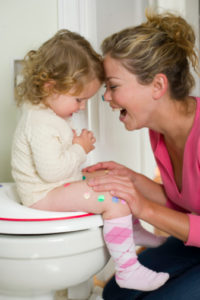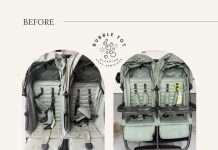
I approached potty training with our first child with a mix of fear (very large accidents in very public places), excitement (see ya, daytime diapers!) and bewilderment (how on earth does one teach another human being to pee and poop in a toilet?).
Fortunately, by that point—2 years, 5 months into my parenting journey—I knew better than to shy away from asking for help. I immediately signed up for a seminar at our local Parents Place family resource center. The one-hour session included plenty of comic relief (a must), but more importantly presented refreshingly straightforward, gimmick-free strategies that really saved our sanity as our son learned to recognize his body’s cues, feel comfortable using bathrooms away from home, and resist the devil on his shoulder urging him, “Don’t stop playing! Who cares about wet underwear?”
As I write this, we are now on Day 4 of potty training our younger child, who just turned 2. We had our kids 18 months apart, so you’d think the memory of the first round would be fresh. But as it happens so often with young children, mommy amnesia kicked in once we had moved from one tricky phase to the next.
Earlier today, I felt my blood pressure skyrocketing after 25 minutes in the bathroom with my daughter, who kept insisting, “Poo-poo is coming!” And then…nada. Turns out she just didn’t want to start her nap. So I dug out my notes from a year ago and regained some perspective.
I’m all about harnessing the power of collective mommy wisdom, so it is in that spirit that I share some tips from the seminar, other mommy friends and our own first-round experience that I found particularly useful:
Signs Your Child Might Be Ready for the Potty:
- Holding pee for longer stretches (happens naturally with age)
- Increased body awareness in general, including “hiding” games
- Interest in the potty, talking about bodily functions, observing others using the potty
Do:
- Frame everything related to potty training in a positive light, and explain that it’s a skill everyone learns at their own pace.
- Compliment other “big kid” behaviors beyond using the potty (i.e. “Look at all the great things you can do because you’re a big kid!”).
- Consider moving diaper changes into the bathroom where the potty is kept (use the sink or put a towel/mat on the floor).
- Shop for underwear and let your child pick it out himself.
- Dress your child in pants/shorts/skirts that are easy for her to pull up and down without help.
Don’t:
- Don’t ask “yes” or “no” questions (“Do you want to go to the potty?”), and instead make suggestions, like, “Let’s go to the potty,” or, “Time for a quick potty break!”
- Don’t constantly ask or remind your child about using the potty.
- Don’t use praise as an ongoing reward, beyond the initial praise for the first few successful potty visits. (Same goes for the sticker/M&M/etc. reward system some parents choose.)
First Steps:
- Implement “naked time”—periods when your child is playing without anything on below the waist, so he/she can start to learn to identify the urge to go. Often, the best time for this is the half hour or so before bath time.
- Establish 4 or 5 “potty visits” each day. For example: First thing in the morning, before going to school, before or after lunch, after nap, and right before bed. Allow 1-2 minutes of sitting on toilet, but don’t let it drag on (potty time is not “party time”).
- If your child seems reluctant to stop what he’s doing to have a potty visit, consider using a timer. (“Oops, the timer says it’s time to try the potty. Then we can go back to playing/go eat lunch, etc.”)
When Accidents Happen:
- Your child will naturally experience certain consequences of accidents, mainly feeling wet and messy, so that will be a motivator on its own.
- Involve your child in cleanup of accidents, but avoid showing any anger or frustration. Keep the mood calm, and avoid lectures: “Everyone has accidents, but now we need to clean up.”
Other Tips:
- Try not to start potty training when there are other major changes going on in the household (new baby, move from crib to bed, etc.).
- Carry a large plastic Ziploc with a change of clothes (and shoes!) on all outings once diapers have been removed.
- For sound sleepers, don’t worry about tackling overnights or naptime until potty training during waking hours has been well established. There’s often a big gap before a child switches to underwear overnight. (Sign that your child is ready for that transition: two weeks of waking up in the morning with a dry diaper—we’re still not there at our house.)
Final note: I really can’t recommend Parents Place enough. Check out upcoming workshops at all their Bay Area locations here: http://parentsplaceonline.org/find-help/learn/workshops/.





















